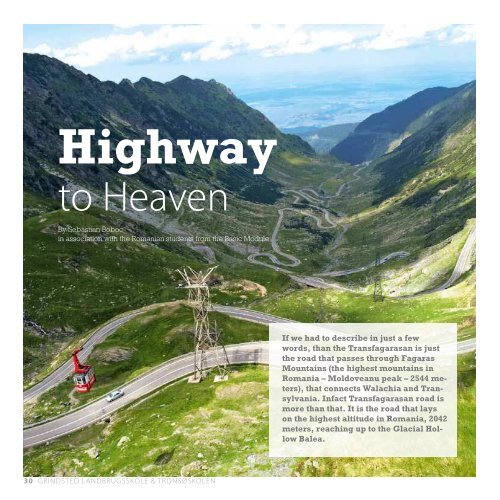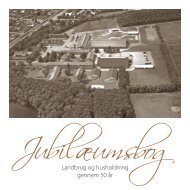Årbogen 2011 - Grindsted Landbrugsskole
Årbogen 2011 - Grindsted Landbrugsskole
Årbogen 2011 - Grindsted Landbrugsskole
Create successful ePaper yourself
Turn your PDF publications into a flip-book with our unique Google optimized e-Paper software.
Highway<br />
to Heaven<br />
By Sebastian Boboc<br />
in association with the Romanian students from the Basic Module<br />
30 grindSTed LandbrugSSkoLe & TronSøSkoLen<br />
If we had to describe in just a few<br />
words, than the Transfagarasan is just<br />
the road that passes through Fagaras<br />
Mountains (the highest mountains in<br />
Romania – Moldoveanu peak – 2544 meters),<br />
that connects Walachia and Transylvania.<br />
Infact Transfagarasan road is<br />
more than that. It is the road that lays<br />
on the highest altitude in Romania, 2042<br />
meters, reaching up to the Glacial Hollow<br />
Balea.<br />
it has two traffic lanes of 92 kilometers<br />
length. because of the countless turns,<br />
the average speed is maximum 40 km<br />
per hour. along this route there are 27<br />
viaducts and bridges, and the longest<br />
road tunnel in romania – 887 meters,<br />
that passes through Paltin Mountains,<br />
from Capra to balea Lake. The ventilation<br />
of the tunnel is made naturally, thanks<br />
to the extremely powerful currents. The<br />
traffic lane inside the unlighted tunnel<br />
is only 6 meters wide and there is a one<br />
meter broad pavement.<br />
The landscape is fantastic, and the differences<br />
of altitude and the curves represent<br />
a challenge for both cars and<br />
drivers. unfortunately, because of the<br />
weather conditions, Transfagarasan road<br />
being covered with snow nearly all year<br />
around, it is open for traffic only a few<br />
months every year, usually from July until<br />
october.<br />
How it was built<br />
Transfagarasan was built between 1970<br />
and 1974. a brief presentation with numbers<br />
might be difficult to follow, but for<br />
those who have the patience to read it is<br />
worth saying that about 3 million tones<br />
of hard rocks were dislocated, 830 transverse<br />
works and 290.000 cubic meters of<br />
masonry were made for building those<br />
92 kilometers of road. For building the<br />
Capra – balea Tunnel there were excavated<br />
over 41.000 cubic meters of rocks.<br />
There were also used 20 tones of dynamite,<br />
3.573 tones of cement, 89 tones of<br />
concrete steel, 24.000 of anchors, 129 tones<br />
of brazed nets, 14.200 square meters<br />
of encasements, 1750 meters of concrete<br />
tubes, 4.100 meters of pipes, 50 tones of<br />
metal composites, 6.900 cubic meters of<br />
grit, 6.000 cubic meters of gravel, 3.000<br />
tones of crushed rocks and 740 lighting<br />
lamps.<br />
Some of those who worked at the construction<br />
of Transfagarasan, nowadays<br />
retired, speak about the sacrifices that<br />
were made for the road that “leads to the<br />
sky”. before its construction, it was impossible<br />
to cross the mountains, not even on<br />
horseback. but it is said that once upon<br />
a time, before becoming president, nicolae<br />
Ceausescu stopped by the village called<br />
arefu and the idea of building a road<br />
that passes through the mountains had<br />
encouraged the built of it. during the<br />
construction a lot of men lost their lives,<br />
like in Vidraru’s case. (Vidraru being an artificial<br />
dam, built in 1965). unfortunately<br />
the documents didn’t keep these numbers,<br />
but the survivors said that there<br />
were about a hundred human sacrifices.<br />
Many of those who died weren’t even<br />
found in the precipices in which they had<br />
fallen. it is also said that when the tunnel<br />
was built, the miners who were in charge<br />
with the planting of the explosives were<br />
hanging on each other, in groups of 20 or<br />
30, not to be thrown by the strong wind<br />
into the precipice.<br />
A monk’s tale<br />
There is also a story that has been sprea-<br />
ding from mouth to mouth referring to<br />
a monk named nectarie. after the construction<br />
of the Transfagarasan road, he<br />
drove along it with his car, a Trabant, right<br />
up to Capra, where he was caught by an<br />
avalanche. it is said that he left the car<br />
and he threw himself on the snow, being<br />
carried away by the “wave”. People say<br />
that he survived and his car was found<br />
empty after 6 months, when the snow<br />
melted.<br />
<strong>Årbogen</strong> <strong>2011</strong> 31<br />
events




